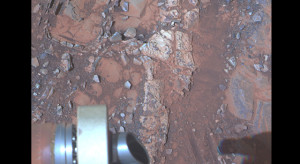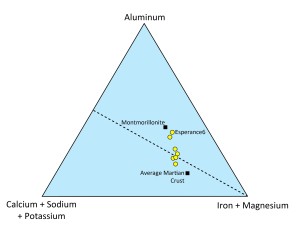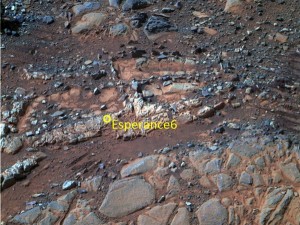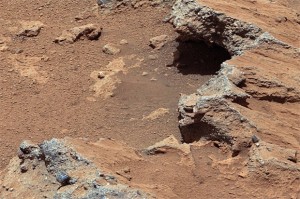by: Nicole Willett
*****UPDATED 9/28/2013*****
 Several papers have been published regarding the findings of Curiosity’s first few month’s on the surface of Mars. The findings are of great importance with regard to water. The rover has confirmed an incredible two percent of the surface soil is composed of water. Scientists said if humans were to land on Mars, they could scoop up soil and heat it up and extract water from it. Estimates suggest that approximately two pints of water is available per cubic foot of soil. This is an astonishing discovery. The benefits for humans that wish to travel to and settle on the Martian surface are immense. NASA stated water is likely spread across the entire planet bound to the soil. The implications of this finding make it much more likely that humans will be able to inhabit the Red Planet in the near future. It also opens up more of the planet for human landing places and settlement opportunities.
Several papers have been published regarding the findings of Curiosity’s first few month’s on the surface of Mars. The findings are of great importance with regard to water. The rover has confirmed an incredible two percent of the surface soil is composed of water. Scientists said if humans were to land on Mars, they could scoop up soil and heat it up and extract water from it. Estimates suggest that approximately two pints of water is available per cubic foot of soil. This is an astonishing discovery. The benefits for humans that wish to travel to and settle on the Martian surface are immense. NASA stated water is likely spread across the entire planet bound to the soil. The implications of this finding make it much more likely that humans will be able to inhabit the Red Planet in the near future. It also opens up more of the planet for human landing places and settlement opportunities.
Original blog published June 9, 2013:
As we anxiously await the results of the latest drill sample from the Curiosity Rover, we have received exciting news from the long lived Opportunity Rover team. Steve Squyres, who will be the recipient of the Mars Pioneer Award 2013 at the 16th Annual Mars Society Convention Aug 15-18th, participated in a NASA teleconference regarding the exciting findings about water on Mars. The fact that once again we have reconfirmed water on Mars is not the exciting part.

Opportunity has spent quite a lot of time working at Endeavor Crater and had to maneuver very strategically to get in position to study a small rock named Esperance. This was a very difficult task for the aging rover, since she has a bad shoulder joint. However the team stated that Opportunity is in extremely good health and has no major concerns as of right now. The rover used several samples from the rock which is the oldest rock that Opportunity has studied. The team showed a graphic, displaying the chemistry of the rocks, with seven measurements taken from different layers. The elements found in Esperance were Aluminum, Iron, Magnesium, Calcium, Potassium, and Sodium. The results from the Alpha Particle X-ray Spectrometer indicate that the

rock was higher in Aluminum and Silica and lower in Calcium and Iron than rocks previously studied by Opportunity. Below the dashed lines are igneous rocks; above the line are rocks including clays (Montmorillomite) that have been altered by water. The lower black square indicates the readings from the average Martian crust. The yellow circles closest to that block indicate the samples taken from the surface of the rock. As the samples ascend vertically above the dashed line it indicates samples that are further inside the rock. The Opportunity team used the Rock Abrasion Tool to reach the subsurface of the rock. Starting at the surface she discovered that the water that had most recently covered Esperance was acidic and the soil more closely resembled the average Martian crust. As the rover progressively scraped and studied Esperance, it was discovered that Mars went through several cycles of water activity in the region where Opportunity is now working. The cycle of water described by the team was that water was present in the area before the Endeavor Crater formed, next the crater formed and the rocks piled up on the crater rim, and then setting water produced gypsum. This is indicative of lengthy multistep and continual water activity. At Esperance the water flowed through the rocks and had a higher clay concentration than the rocks studied at Matijevic Hill. A high clay concentration is evidence of water that had a neutral pH. “There appears to have been extensive, but weak, alteration of Whitewater Lake, but intense alteration of Esperance along fractures that provided conduits for fluid flow,” Squyres said. “Water that moved through fractures during this rock’s history would have provided more favorable conditions for biology than any other wet environment recorded in rocks Opportunity has seen.”

The big news was that the Opportunity team stated was that water with a neutral pH is very conducive to prebiotic chemistry. We know there are organisms on Earth that survive in an acidic environment, but the science points to prebiotic chemistry favoring a neutral pH. Squyres stated that this is the best that we have found with Opportunity, the most compelling evidence for habitability. The most fundamental conditions for habitability were present at this location. The NASA team also stated that this was water that could have been consumed. This is a familiar statement to that of the Curiosity team a few months ago. The Curiosity team found an ancient riverbed in Gale

Crater and also found that the water that flowed there was freshwater that was neutral in pH and could have also been consumed. At a press conference in March 2013 Dr. John Grotzinger, project scientist for the Curiosity mission, went so far as to state, “We have found a habitable environment. The water that was here was so benign and supportive of life that if a human had been on the planet back then, they could drink it.”
This pattern may seem redundant to some; however we must follow the scientific method of testing and retesting, confirming and reconfirming. We must verify these results many times because there will be humans on Mars and we must know as much about our future home as possible. There are many reasons for this, some are obvious and some we haven’t even thought of yet. These results are exciting and very important to the future exploration and settlement of the Red Planet. ~On To Mars
[Images: NASA/JPL]

